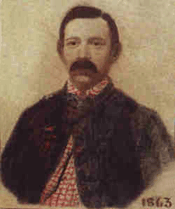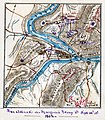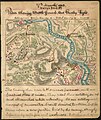
Robert Knox Sneden (1832–1918) was an American landscape painter and a map-maker for the Union Army during the American Civil War. He was a prolific illustrator and memoirist documenting the war and other events.
Early life
Robert Knox Sneden was born in Annapolis Royal, Nova Scotia, Canada and moved to New York City in 1851 at age 19. He received some architectural education.
Civil War
Sneden left Brooklyn in 1861 to enlist in the 40th New York Volunteer Infantry Regiment, or the Mozart Regiment, of the Army of the Potomac. He served as a quartermaster when his regiment camped near Leesburg Turnpike. Starting from January 12, 1862, Sneden served on Samuel P. Heintzelman's III Corps staff, at first, as a draughtsman on map work, later, as a topographical engineer. On March 22, 1862, Sneden embarked with Heintzelman for the Peninsula Campaign, participating in the Battle of Williamsburg, Battle of Seven Pines, Battle of Savage's Station, and Battle of Glendale. Returning to Northern Virginia, he took part in the Second Battle of Bull Run. He was assigned to the defenses of Washington, D.C., first in Alexandria, Virginia, then at Arlington House.
In October, 1863, after the Battle of Bristoe Station, he was assigned to David B. Birney's division, participating in the Battle of Kelly's Ford.
He was assigned to the staff of general William H. French, during the abortive Battle of Mine Run.
Prisoner-of-War
On November 27, 1863, Sneden was captured by Confederate rangers under John S. Mosby and became a prisoner of war for the next thirteen months. In November 1863, he was held at a tobacco warehouse next to Libby Prison, where he suffered from typhoid fever. On February 22, 1864, after a prison escape, prisoners were shipped to a new camp in Georgia. Sneden was placed in the notorious Andersonville Prison, but continued making clandestine drawings. Altogether, he sketched scenes of prison life in Savannah and Millen, Georgia, and in Florence and Charleston, South Carolina. On December 11, 1864, he was exchanged at Charleston.
Later life
After the Civil war, although crippled from his time in Andersonville, Sneden returned to Brooklyn, where he was already declared dead or missing. He made a number of his war sketches into watercolors, leaving a legacy of close to 1000 watercolors, drawings, sketches, maps, and diagrams. Sneden contributed some of them to the Battles and Leaders of the Civil War, a series of articles published between 1884 and 1887 in The Century Magazine and then reissued as a four-volume set of books.
Sneden never married and devoted the rest of his life to preserving the Civil war memory. In 1918, Sneden died in New York State Soldiers' and Sailors' Home.
Recognition
In 1994, an art dealer approached the Virginia Historical Society about a Civil War archive that had languished in a Connecticut bank vault. Robert Sneden's great-great-nephew also transferred through purchase Sneden's diary and watercolors, close to 5,000 pages of the diary entries and memoirs, and near 500 watercolors and maps.
In the fall of 2000, Sneden was rediscovered by the general public and the Civil war enthusiasts after about 300 pieces of his artwork were revealed in the Eye of the Storm exhibition and subsequent book, which became a bestseller. According to the Virginia Historical Society, it was, "the largest collection of Civil War soldier art ever produced". Documentary-style images created by Sneden are considered as important historical records.
His works are currently held by the Virginia Historical Society, and also are available through the Library of Congress.
-
 Fort Monroe, 1865
Fort Monroe, 1865
-
 A restored version of Sneden's map for the Battle of Harpers Ferry
A restored version of Sneden's map for the Battle of Harpers Ferry
-
 Map showing a battle ground at Kelly's Ford, Virginia
Map showing a battle ground at Kelly's Ford, Virginia
-
 Siege of Port Hudson
Siege of Port Hudson
-
 Forts near Alexandria, Virginia
Forts near Alexandria, Virginia
-
 Fort Lyon Diagram
Fort Lyon Diagram
-
 Siege of Fort Pulaski
Siege of Fort Pulaski
-
 Siege of Charleston
Siege of Charleston
-
 Plan of Andersonville Prison
Plan of Andersonville Prison
See also
References
- ^ Eye of the Storm: The Civil War Drawings of Robert Knox Sneden, Virginia Historical Society.
- ^ Robert Knox Sneden (2000). Charles F. Bryan, Nelson D. Lankford (ed.). Eye of the Storm. The Free Press. ISBN 0-684-86365-0.
- Rebecca Onion. How to Sketch a Terrible Place: A Union POW's Hand-Drawn Map of Andersonville Prison, Slate
- Eric A. Powe. Sneden's Legacy: How a Union captive's art is helping historians and archaeologists, Archaeology Magazine, a Publication of the Archaeological Institute of America , October 14, 2010.
- A Civil War POW Camp in Watercolor, Archaeology Magazine, a Publication of the Archaeological Institute of America , 2016.
- Publisher description for Images from the storm: 300 Civil War images / written and illustrated by Robert Knox Sneden; edited by Charles F. Bryan, Jr., James C. Kelly, Nelson D. Lankford, Library of Congress
- Battles and Leaders of the Civil War
- Susan Schulten. What Private Sneden Saw, The New York Times, July 31, 2012.
- Sneden, Robert Knox, 1832-1918, Civil War Maps, Library of Congress
Further reading
- Robert Knox Sneden (2000). Charles F. Bryan; Nelson D. Lankford (eds.). Eye of the Storm. The Free Press. ISBN 0-684-86365-0.
- Robert Knox Sneden's Diary, Volumes 1-7, Virginia Historical Society
External links
- The Sneden Civil War Collection online exhibition, Virginia Historical Society
- Works by Robert Knox Sneden available online via the Library of Congress
- Library resources in your library and in other libraries by Robert Knox Sneden